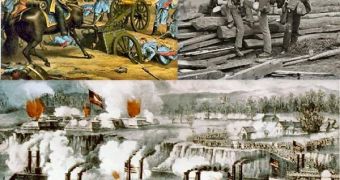During the Civil War, the city of Galveston, Texas, came under a ship blockade from the attacking Union forces, which tried to conquer it, but failed. Under Major General John B. Magruder, Confederate forces held the city throughout the duration of the war, but failed to break the blockade. Many vessels made such attempts and found themselves sunken by the Northern forces in the Gulf of Mexico. The Carolina, also known as the Caroline, was one of the ships that unsuccessfully sought to break through the blockade and went down. Experts now believe that Hurricane Ike may have dug her out.
The merchant vessel was reportedly sunken in 1864, while carrying cotton for the Confederates. Its carcass fell to the Gulf floor, where it remained for more than a century, next to those of about a dozen other ships that suffered the same fate at the hands of the Union vessels.
Only a couple of days ago, Texas contractors that were scanning the ocean floor for signs left behind by the passing of Hurricane Ike discovered what could very well be the old wreck. In all likelihood, the severe storm broke the ship loose of its “tomb,” and brought it within the range of this modern equipment.
Speaking to the Houston Chronicle newspaper, Texas Historical Commission marine archaeologist Steven Hoyt said that the shape discovered on the sonars was similar to a merchant vessel, and that its dimensions corresponded as well. The vessel did not sink intact, as the crew first ran it in shallow waters, then set fire to it. Because its size was considerably reduced afterwards, the wreck was most likely buried in the sands of the Gulf until Hurricane Ike disturbed them under the water.
Hoyt argued that the region of the ocean floor that had been lately scanned would not be accessible to divers or other investigators until the summer, when the waters in the Gulf of Mexico were bound to be calmer than they were at the moment. “It's certainly significant if it turns out to be a historic wreck, as we think it is,” he told the newspaper. Even in the summer, the visibility inside the water may be too low to allow for concise scientific observations, and other instruments, such as unmanned submarines, might have to be used.
Jim Suydam, general land office spokesman, shared that state-hired contractors had made the find while checking out the ocean floor for debris that might have been taken there during Hurricane Ike. The team has already found numerous refrigerators and washing machines, furniture, and even a shrimp boat. The area needs to be cleared of this junk so that commercial shipping will face no more challenges when ships arrive in the region.

 14 DAY TRIAL //
14 DAY TRIAL //